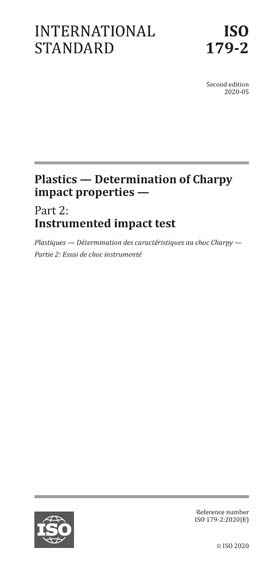Most recent
ISO 179-2:2020
Plastics - Determination of Charpy impact properties - Part 2: Instrumented impact test
1.1 This document specifies a method for determining Charpy impact properties of plastics from force-deflection diagrams. Different types of rod-shaped test specimens and test configurations, as well as test parameters depending on the type of material, the type of test specimen and the type of notch, are defined in ISO 179-1.
Dynamic effects such as load-cell/striker resonance, test specimen resonance and initial-contact/inertia peaks are described in this document (see Figure 1, Curve b, and Annex A).
1.2 ISO 179-1 is suitable for characterizing the impact behaviour by the impact strength only and for using apparatus whose potential energy is matched approximately to the particular energy to break to be measured (see ISO 13802:2015, Annex E). This document is used to record a force-deflection or force-time diagram for detailed characterization of the impact behaviour, and for developing automatic apparatus, i.e. avoiding the need to match energy.
The method described in this document is also suitable for:
— acquiring more and different materials characteristics under impact conditions;
— supervising the Charpy test procedure, as this instrumentation allows detection of typical operational mistakes, such as the specimen not being in close contact with the supports;
— automatically detecting the type of break;
— pendulum type instruments to avoid frequent changes of pendulum hammers;
— measuring fracture mechanical properties described in other ISO standards.
1.3 For the range of materials which can be tested by this method, see ISO 179-1:2010, Clause 1.
1.4 For the general comparability of test results, see ISO 179-1:2010, Clause 1.
1.5 Information on the typical behaviour of materials can be obtained by testing at different temperatures, by varying the notch radius and/or specimen thickness and by testing specimens prepared under different conditions.
It is not the purpose of this document to give an interpretation of the mechanism occurring at every point on the force-deflection diagram. These interpretations are a task for on-going scientific research.
1.6 The test results obtained with this method are comparable only if the conditions of test specimen preparation, as well as the test conditions, are the same. The impact behaviour of finished products cannot, therefore, be predicted directly from this test.
Content Provider
International Organization for Standardization [iso]






